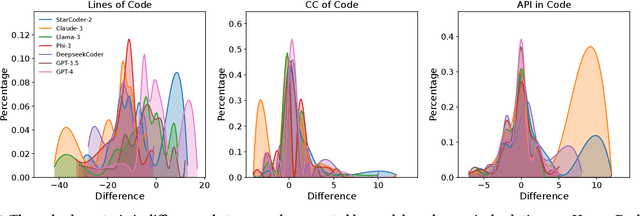Mingxu Chai
DocFusion: A Unified Framework for Document Parsing Tasks
Dec 17, 2024



Abstract:Document parsing is essential for analyzing complex document structures and extracting fine-grained information, supporting numerous downstream applications. However, existing methods often require integrating multiple independent models to handle various parsing tasks, leading to high complexity and maintenance overhead. To address this, we propose DocFusion, a lightweight generative model with only 0.28B parameters. It unifies task representations and achieves collaborative training through an improved objective function. Experiments reveal and leverage the mutually beneficial interaction among recognition tasks, and integrating recognition data significantly enhances detection performance. The final results demonstrate that DocFusion achieves state-of-the-art (SOTA) performance across four key tasks.
Modeling Layout Reading Order as Ordering Relations for Visually-rich Document Understanding
Sep 29, 2024Abstract:Modeling and leveraging layout reading order in visually-rich documents (VrDs) is critical in document intelligence as it captures the rich structure semantics within documents. Previous works typically formulated layout reading order as a permutation of layout elements, i.e. a sequence containing all the layout elements. However, we argue that this formulation does not adequately convey the complete reading order information in the layout, which may potentially lead to performance decline in downstream VrD tasks. To address this issue, we propose to model the layout reading order as ordering relations over the set of layout elements, which have sufficient expressive capability for the complete reading order information. To enable empirical evaluation on methods towards the improved form of reading order prediction (ROP), we establish a comprehensive benchmark dataset including the reading order annotation as relations over layout elements, together with a relation-extraction-based method that outperforms previous methods. Moreover, to highlight the practical benefits of introducing the improved form of layout reading order, we propose a reading-order-relation-enhancing pipeline to improve model performance on any arbitrary VrD task by introducing additional reading order relation inputs. Comprehensive results demonstrate that the pipeline generally benefits downstream VrD tasks: (1) with utilizing the reading order relation information, the enhanced downstream models achieve SOTA results on both two task settings of the targeted dataset; (2) with utilizing the pseudo reading order information generated by the proposed ROP model, the performance of the enhanced models has improved across all three models and eight cross-domain VrD-IE/QA task settings without targeted optimization.
What's Wrong with Your Code Generated by Large Language Models? An Extensive Study
Jul 08, 2024



Abstract:The increasing development of large language models (LLMs) in code generation has drawn significant attention among researchers. To enhance LLM-based code generation ability, current efforts are predominantly directed towards collecting high-quality datasets and leveraging diverse training technologies. However, there is a notable lack of comprehensive studies examining the limitations and boundaries of these existing methods. To bridge this gap, we conducted an extensive empirical study evaluating the performance of three leading closed-source LLMs and four popular open-source LLMs on three commonly used benchmarks. Our investigation, which evaluated the length, cyclomatic complexity and API number of the generated code, revealed that these LLMs face challenges in generating successful code for more complex problems, and tend to produce code that is shorter yet more complicated as compared to canonical solutions. Additionally, we developed a taxonomy of bugs for incorrect codes that includes three categories and 12 sub-categories, and analyze the root cause for common bug types. Furthermore, to better understand the performance of LLMs in real-world projects, we manually created a real-world benchmark comprising 140 code generation tasks. Our analysis highlights distinct differences in bug distributions between actual scenarios and existing benchmarks. Finally, we propose a novel training-free iterative method that introduces self-critique, enabling LLMs to critique and correct their generated code based on bug types and compiler feedback. Experimental results demonstrate that our approach can significantly mitigate bugs and increase the passing rate by 29.2% after two iterations, indicating substantial potential for LLMs to handle more complex problems.
EasyJailbreak: A Unified Framework for Jailbreaking Large Language Models
Mar 18, 2024Abstract:Jailbreak attacks are crucial for identifying and mitigating the security vulnerabilities of Large Language Models (LLMs). They are designed to bypass safeguards and elicit prohibited outputs. However, due to significant differences among various jailbreak methods, there is no standard implementation framework available for the community, which limits comprehensive security evaluations. This paper introduces EasyJailbreak, a unified framework simplifying the construction and evaluation of jailbreak attacks against LLMs. It builds jailbreak attacks using four components: Selector, Mutator, Constraint, and Evaluator. This modular framework enables researchers to easily construct attacks from combinations of novel and existing components. So far, EasyJailbreak supports 11 distinct jailbreak methods and facilitates the security validation of a broad spectrum of LLMs. Our validation across 10 distinct LLMs reveals a significant vulnerability, with an average breach probability of 60% under various jailbreaking attacks. Notably, even advanced models like GPT-3.5-Turbo and GPT-4 exhibit average Attack Success Rates (ASR) of 57% and 33%, respectively. We have released a wealth of resources for researchers, including a web platform, PyPI published package, screencast video, and experimental outputs.
 Add to Chrome
Add to Chrome Add to Firefox
Add to Firefox Add to Edge
Add to Edge